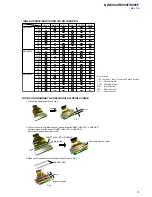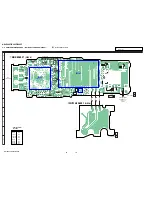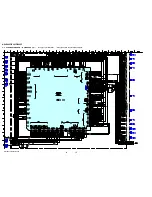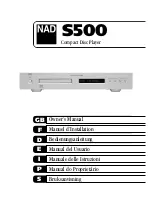
2
NW-E002F/E003F/E005F
TABLE OF CONTENTS
1.
GENERAL
...................................................................
5
2.
DISASSEMBLY
2-1.
Disassembly Flow ...........................................................
6
2-2.
Cabinet (Top) ...................................................................
7
2-3.
Cabinet (Low) Assy .........................................................
7
2-4.
MAIN Board-1 ................................................................
8
2-5.
MAIN Board-2 ................................................................
9
2-6.
Battery (A) Assy ..............................................................
9
2-7.
Organic EL Indicator Module ......................................... 10
3.
TEST MODE
............................................................... 11
4.
DIAGRAMS
4-1.
Block Diagram ................................................................ 13
4-2.
Printed Wiring Boards
– MAIN, SWITCH Board (Side A) – .............................. 14
4-3.
Printed Wiring Boards
– MAIN, SWITCH Board (Side B) – .............................. 15
4-4.
Schematic Diagram – MAIN Board (1/3) – ................... 16
4-5.
Schematic Diagram – MAIN Board (2/3) – ................... 17
4-6.
Schematic Diagram
– MAIN Board (3/3), SWITCH Board – ......................... 18
5.
EXPLODED VIEWS
5-1.
Overall-1 .......................................................................... 26
5-2.
Overall-2 .......................................................................... 27
5-3.
Overall-3 .......................................................................... 28
5-4.
Overall-4 .......................................................................... 29
6.
ELECTRICAL PARTS LIST
.................................. 30
UNLEADED SOLDER
Boards requiring use of unleaded solder are printed with the lead-
free mark (LF) indicating the solder contains no lead.
(Caution: Some printed circuit boards may not come printed with
the lead free mark due to their particular size)
: LEAD FREE MARK
Unleaded solder has the following characteristics.
•
Unleaded solder melts at a temperature about 40
°
C higher
than ordinary solder.
Ordinary soldering irons can be used but the iron tip has to be
applied to the solder joint for a slightly longer time.
Soldering irons using a temperature regulator should be set to
about 350
°
C.
Caution: The printed pattern (copper foil) may peel away if
the heated tip is applied for too long, so be careful!
•
Strong viscosity
Unleaded solder is more viscou-s (sticky, less prone to flow)
than ordinary solder so use caution not to let solder bridges
occur such as on IC pins, etc.
•
Usable with ordinary solder
It is best to use only unleaded solder but unleaded solder may
also be added to ordinary solder.
Flexible Circuit Board Repairing
•
Keep the temperature of the soldering iron around 270
°
C
during repairing.
•
Do not touch the soldering iron on the same conductor of the
circuit board (within 3 times).
•
Be careful not to apply force on the conductor when soldering
or unsoldering.
• Microsoft, Windows, Windows NT and Windows Media are trademarks or
registered trademarks of Microsoft Corporation in the United States and/or
other countries.
• Adobe and Adobe Reader are trademarks or registered trademarks of Adobe
Systems Incorporated in the United States and/or other countries.
• MPEG Layer-3 audio coding technology and patents licensed from
Fraunhofer IIS and Thomson.
• IBM and PC/AT are registered trademarks of International Business
Machines Corporation.
• Macintosh is a trademark of Apple Computer, Inc..
• Pentium is a trademark or a registered trademark of Intel Corporation.
• CD and music-related data from Gracenote, Inc., copyright © 2000-2004
Gracenote.
Gracenote CDDB
®
Client Software, copyright 2000-2004 Gracenote. This
product and service may practice one or more of the following U.S. Patents:
#5,987,525; #6,061,680; #6,154,773, #6,161,132, #6,230,192, #6,230,207,
#6,240,459, #6,330,593, and other patents issued or pending. Services
supplied and/or device manufactured under license for following Open
Globe,Inc. United States Patent 6,304,523. Gracenote and CDDB are
registered trademarks of Gracenote.
The Gracenote logo and logotype, and the “Powered by Gracenote” logo are
trademarks of Gracenote.
Notes on chip component replacement
•
Never reuse a disconnected chip component.
•
Notice that the minus side of a tantalum capacitor may be
damaged by heat.
Ver. 1.1



































